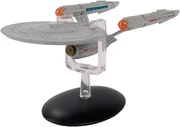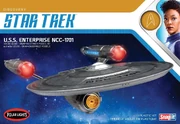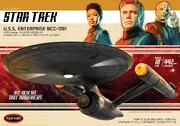(written from a Production point of view)

The Constitution class as it appears in Discovery
A new, retconned CGI studio model for the Constitution-class, co-designed by John Eaves, was introduced in the first season finale for Star Trek: Discovery, "Will You Take My Hand?". The retcon design was said to bring the USS Enterprise more in line with Federation aesthetics as seen in Star Trek: Enterprise and Star Trek: The Motion Picture. That being said however, the various remarks made below by production staffers on the design, implied that the actual reason for the redesign was to bring Enterprise in line with the aesthetics as employed in Discovery (aka the "the sleek, unique Discovery look" as coined by Eaves below).
The redesign does away with the classic smooth hull look and adds detail such as phaser ball turrets and photon torpedo launchers. The saucer was also slightly changed adding in a larger aft section, housing the impulse engines. The ship was also upscaled from its original size, by over 50% according to co-designer Eaves, again in order to comply with the Discovery aesthetics. (Star Trek: The Official Starships Collection, Issue XL11, p. 16) Ironically, the swept-back nacelle pylon configuration was something original Designer Matt Jefferies had already conceived back in 1964 as a fall back option had the then-producers not liked the configuration as ultimately employed in Star Trek: The Original Series, but which was adopted for his later 1977 Constitution II-class model (co-)redesign. (Star Trek: The Magazine Volume 2, Issue 8, p. 84).

|
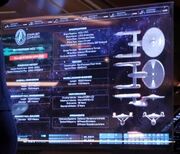
|
The episode was set in 2257, after the events of the original Star Trek pilot "The Cage", but before the events of the second pilot for The Original Series, "Where No Man Has Gone Before". The retcon design is intended for 21st century audiences as a modernized version of the original "classic" design within the prime timeline, and consequently meant to be one and the same in canon, [1] even though the original Jefferies design was used for the USS Defiant in the Enterprise season 4 episodes "In a Mirror, Darkly" and "In a Mirror, Darkly, Part II", and in the Discovery episode "Despite Yourself" earlier in the first season, albeit as a slightly modified wire-frame graphic only [2] – which was intended to show the upgrades the Terran Empire had performed on the ship since its capture, as per Producer Ted Sullivan. [3]
Moreover, an adapted Original Series configuration, more conforming to Jefferies' classic lines, was seen on three USS Discovery bridge computer displays as Enterprise itself in the second season episode "Brother", when the ship's files were being accessed.
Design[]
According to an article entitled "Designing The Enterprise" included in the booklet accompanying the 2018 Eaglemoss XL model of the ship (Star Trek: The Official Starships Collection, Issue XL11, pp. 6-19), the task of redesigning the vessel was initially assigned to John Eaves, in collaboration with Scott Schneider and William Budge, by then-production designer Todd Cherniawsky, prior to Cherniawsky being replaced in that capacity by Tamara Deverell, who then continued to oversee the trio's work. After briefly considering a radical departure from previous depictions, the designers instead aimed, in Eaves' words, "to get as close as possible to the original", yet add "the sleek, unique Discovery look to it."

Different nacelle struts and impulse engines
Having settled on an interpretation that the resulting configuration would be "the same ship that Kirk commanded at an earlier stage of its life, before several refits…that various components such as the warp nacelles or the impulse engines would be replaced over time…they set about designing more primitive versions of them." (2018 Eaglemoss booklet, pp. 7-8) Eaves recalled, "We were trying to do things that implied it could transition to the original Matt Jefferies ship later on…we wanted to create links with ships that had come before…for example, we rotated the exhaust ports on the back of the nacelles 90 degrees inward. On the Phoenix those had faced each other like that." (2018 Eaglemoss booklet, pp. 8-9) Schneider elaborated, "We were constantly trying to tie into both the past and future architecture of Starfleet ships…we tried to tie stuff into the NX-01 and stuff that would come in the future, like the Enterprise-B…in the beginning, we had the ball on the back of the nacelles…later on, we got into a meeting with Tamara…and I said…time-wise we should…put grilles in there instead…we wanted to show some connection to the motion picture refit…get some of those details that you see on the refit in there, but to make it look as if they were in their earlier stages…they've got aft torpedoes here and eventually on the refit they move it to the neck." (2018 Eaglemoss booklet, pp. 9-12)
Schneider said of Budge's role (2018 Eaglemoss booklet, p. 12), "William was constantly keeping us in check…watching over things to make sure we maintained continuity with all the other ships from the Discovery era. There were times when he'd say, 'OK this is great, but we've got established details on the rest of the fleet that we need to carry over." These details included exterior lighting features such as the "wedge" of "segmented lights in front of the bridge" (2018 Eaglemoss booklet, p. 9) and the bridge viewscreen window typical of Discovery-era vessels. To reconcile this window with Jefferies' original design, Schneider devised the idea that the forward part of the bridge superstructure would be made of transparent aluminum, which "during battle would go opaque and during exploration mode…would go transparent", revealing the window. (2018 Eaglemoss booklet, p. 17)
Another Discovery-style feature initially included in their submitted design was "a double-pronged antennae on the front" of the deflector dish. (2018 Eaglemoss booklet, p. 9) This, along with the the nacelle pylons, which, per comments made by Eaves on Facebook, had been "split…so in time the cooling vent side could be removed to make it more like the original TOS strut", with Schneider adding in regard to their original, almost approved design, "We had straight pylons…we never considered the swept [design] because we felt it would be jumping forward in time for one element", and other cosmetic details were further revised by the visual effects team after leaving the hands of the designers. [4]
In the same Facebook post, subsequently deleted, Eaves reiterated his conception that "the advantage of a ten-year gap in Trek history" allowed them "to retro the ship a bit with elements that could be removed and replaced, somewhere in the time frame of Discovery and The Original Series." Eaves further suggested that the assignment "started with the guideline that the Enterprise for Discovery had to be 25% different" from the original due to issues of "Star Trek ownership" between Paramount Pictures and CBS Studios Inc.. In the same discussion, Schneider suggested that this was a "legal" requirement "in order to avoid copyright infringement", though self-admittedly he "know[s] nothing of copyright law". [5] This was in fact false. Schneider's statements were part of a different conversation regarding the history of the 25% rule and its origins. Schneider's statement about "legal" was in reference to how the 25% rule was applied years before on an unrelated project. It in no way was in reference to Star Trek or the Enterprise design. (citation needed • edit) However, after these comments were reported by several sources, [6] among others the by CBS Interactive owned ComicBook.com, this claim was very shortly thereafter refuted by an anonymous CBS Television spokesperson on the same ComicBook.com (where the initial report was dutifully deleted), clarifying that "CBS TV Studios does, in fact, own the rights to the designs for the USS Enterprise seen on previous Star Trek television series", and that "any changes made to the design of the Enterprise were creative ones to utilize 2018 VFX technology." [7]
Schneider added, "There are extra details that John and I put in that you won't even see in the show…I had photographs of the original model…I was always referring back to them. There are little details. On the original they never actually show where the phaser banks were…where the torpedoes were. They would just magically come out of the hull. So we built all those details in. We put in the RCS thrusters that they didn't have…but which must have been there for the ship to work…we put in a warp core ejection hatch and we put in tractor beams…we put in rear phaser banks…". Eaves elaborated that these functions were assigned to external features intentionally reminiscent of details found on the original model, and that many of the original "call out numbers" applied to various surfaces of the original were included on their submitted version, supplemented by "initials and the birth dates of people that had an influence on the design of the Enterprise", among them Matt Jefferies, Andrew Probert, Doug Drexler, Bill George, and Gene Roddenberry, in addition to Schneider and Budge. However, Eaves expressed doubt that these survived in the final rendition used onscreen. (2018 Eaglemoss booklet, pp. 10-11)
Another nod to the original was included in Schneider's concept for the bridge turbolift (2018 Eaglemoss booklet, p. 18), "You have an elevator shaft on the center line and two standby elevators off to the side. So one would slide back and over and go down the tube and another one would come in. This is why you could get an elevator quickly because there's always at least two standing by and that explained why there is a center shaft."
At first Eaves and Schneider stayed very close to the classic lines as set by Matt Jefferies and this version they submitted October 2017 actually nearly made the cut, before it was decided at the eleventh hour to go for a more radical redesign. Nonetheless, the producers decided to leave the preliminary smooth skinned version of this iteration, along with listing dimensions and other specifications copied from Franz Joseph's Star Fleet Technical Manual, as the graphic display in "Brother", intended to be an "Easter egg for the [diehard] fans", as Deverell had put it at the 9 February 2019 Directors Guild of Canada's season one finale screening. [8]
The size of the ship was an issue of contention during the redesign process. Eaves summarized (2018 Eaglemoss booklet, p. 16), "The scale would go up and down…were we going to keep the scale of the original scenes or was it going to be increased to match the size of the Discovery ships…it was decided we were going to go with the 1500-foot scale range so the windows had to be adjusted, but we still tried to keep that TOS pattern of what the windows looked like." Deverell stated at the March 2018 WonderCon event, "For the Enterprise, we based it initially off of The Original Series. We were really drawing a lot of our materials from that. And then we particularly went to more of the Star Trek movies, which is a little bit fatter, a little bit bigger. Overall, I think we expanded the length of it to be within the world of our Discovery, which is bigger, so we did cheat it as a larger ship." [9] [10] [11]
CGI model[]
Even though the production CGI model of the Enterprise was eventually turned over in October 2017 to the modellers of primary (digital) visual effects vendor Pixomondo for rendering and further finetuning in preparation for use in the live-action production(s), the model itself was not constructed by any of Pixomondo's usual staff, but rather by studio staffer Scott Schneider, who had started his work in April 2017. (Star Trek: Discovery Designing Starships, pp. 196 & 203) In a way this was highly unusual as Schneider's regular duty on the show was that of concept set designer, but not that surprising in hindsight as he was also (co-)responsible for the redesign of the Enterprise's interior sets, most conspicuously the bridge; taking on the build of the model allowed Schneider to closely align the redesigned exteriors with the redesigned interiors. (Star Trek: Discovery Designing Starships, pp. 200-202) When he was reverted the chore (therefore in effect following in the footsteps of his illustrious predecessor Matt Jefferies), Schneider was initially very reluctant to take on the assignment as he was "(...)so terrified of the fans’ reaction" – not entirely unjustified. Co-designer and personal friend Eaves had some persistent convincing to do, before Scnheider conceded to do so eventually. [12] Nonetheless, and aside from feeling honored to have been able to work on Jefferies' iconic starship, Schneider cited his work as "[t]he best time I've had in many years", because of him having been able to work with Eaves and Budge. (Star Trek: Discovery Designing Starships, p. 203)
It was while he was constructing the various iterations of the model in Rhino 3D software that Schneider contributed his design inputs. (Star Trek: The Art of John Eaves, p. 203) When the finished model was turned over to the modellers of Pixomondo in preparation for production use, it was converted into the company's software package of choice, Autodesk Maya, and who "basically rebuilt it" as Schneider had put it. (Star Trek: Discovery Designing Starships, p. 202) It was the Pixomondo modellers who implemented the last minute changes that eventually resulted in the onscreen version as ultimately featured in the series, such as the swept-back nacelle pylon configuration, the lengthened nacelles, the thickened neck and pylons, and other dimensional and proportional changes in order to meet Deverell's above-mentioned requirement to "cheat it as a larger ship". It was only two weeks before the redesign was slated to make its first onscreen appearance that Eaves and Schneider – who had no further design input while the model was being prepared at Pixomondo – were acquainted with the final version. (Star Trek: Discovery Designing Starships, pp. 202-203)
Derivative physical models[]
While a physical studio model is not utilized as a production asset for Discovery, the CGI meshes created for the show were nonetheless utilized as masters in order to bring the retcon Constitution-class model into the physical realm as merchandise, most notably display models.
Anovos produced a upscale "Studio-Scale Filming Miniatures" of the retcon Constitution class USS Enterprise, along with a number of Eaglemoss and QMx products. [13] [14]
In January 2018, Eaglemoss Collections' Hero Collector brand premiered the Star Trek: Discovery The Official Starships Collection partwork which featured the retcon USS Enterprise in March 2019 as the regular issue 12. Nonetheless, a larger version of the model was in December 2018 first released in the mother publication Star Trek: The Official Starships Collection as issue XL11.
The by Pixomondo in Maya created final production CGI model, which served as the computer template from which the display models were constructed, needed conversion yet again into LightWave 3D, Eaglemoss' software package of choice for their publications, which was entrusted to Fabio Passaro. [15]
A first model kit of the redesign has followed suit when it was released by Polar Lights (No. POL971) in late 2019. A larger scaled model has subsequently been released in June 2020 (No. POL973M).
Legacy[]
Unsurprisingly perhaps, the portmanteau moniker "Discoprise" surfaced on the internet shortly after the on-screen introduction of the redesign. While sometimes used as a term of endearment by merchandise vendors and Discovery fans, it was also on occasion used in a more sarcastic manner by those fans who questioned the wisdom of the in their eyes too radical redesign of the iconic starship. [16] As the majority of fans were realistic enough to realize that the 1960s aesthetics needed some adjustment in order to conform to those of the 2010s, [17] the ship's (exterior) redesign did not spark a discourse as vehement as, for example, the as far more radically perceived re-imagining of the Klingons and their culture where visual continuity was concerned, and which was in no small measure due to the conscientious work done by Eaves and Schneider – both known to be Original Series fans – trying to get in as much Original Series elements as they could get away with in the face of superiors who had very different point of views. (Star Trek: Discovery Designing Starships, pp. 194-196)
Echoing similar concerns expressed in the wake of the contentious 1991/1992 restoration of the original studio model (which, ironically, primarily revolved around the non-canon presence of the pronounced ventral saucer grid-lines, now prominently present on the reton-design), those fans who did feel that the producers had taken the redesign too far, [18] followed in the footsteps of their prior (more critical) predecessors who had coined the similar qualifier "Akiraprise" in regard to their reservations concerning the NX class model design nearly two decades earlier.
Nevertheless, the franchise was to some extent aware of the dissenting opinions of those fans, as model kit company Polar Lights felt apparently compelled to emphatically point out that the new design was "Fan-approved" in their June 2020 model kit listing on their official website. [19](X)
As it turned out in 2021, redesigner John Eaves shared some of the misgivings about the last-minute Pixomondo modifications the critical fans had, when he embarked on the redesign of another Original Series classic shipdesign, that of the Romulan Bird-of-Prey. He stated on that ocassion, "There were a lot of little change to make it a PICARD ship, but we kept it very tight to the original. That doesn't happen too often. Usually when they ask for a classic you have to modify it greatly. It was nice not to have to alter Wah Chang's design too much." (Star Trek Universe: The Official Starships Collection, issue 3, p. 9) The retcon-Enterprise and the Klingon D7-class were the only two other classic designs to have been redesigned in Kurtzman-era Star Trek up until that point in time, the latter redesign adhering more closely to its original than that of the Enterprise had to its. Furthermore, the D7-class was redesigned during Eaves's absence from the franchise by his former partner Schneider in the wake of the massive fan criticism of the complete re-imagining of the Klingons and their ships, making it clear that Eaves was referring to his own redesign in a veiled manner.
Retcon design canon status[]
While the onscreen appearance in Discovery of the retcon redesign had made it undeniably canon, the series had subsequently shied away from explaining in canon the in-universe visual exterior configuration differences of Enterprise between "The Cage" and the Original Series, beyond the ephemeral, oral only, references to faulty upgrades in the single second season episode "An Obol for Charon". The fleeting appearance of Jefferies' classic design in the prologue of the later episode "If Memory Serves" (composited from footage taken from "The Cage"/"The Menagerie"), provided an additional hint that both design configurations existed along each other in the prime universe, besides Defiant's earlier featured wire-frame graphic.
There were indications however, that the Discovery, and beyond, producers consider their version the definitive canon replacement for Jefferies' classic design – that is, in their minds at least. On top of the above made remarks by the anonymous studio representative in response to Eaves' facebook posting, and the one made by Deverell in regard to size, showrunner Alex Kurtzman went on record, shortly before the retconned Enterprise made its onscreen debut, indicating,
"Obviously [Discovery] looks more modern than The Original Series, because we are in a modern world now and if we made the show look that way people would not feel that it was worth the money. That being said, every prop and costume design is filtered through what existed at the time. And do we create the new version of it or do we augment the original design in very subtle ways or do we just leave it alone? And when I say every prop and design choice I mean every [note: "every" emphasized] prop and design choice. So, I think you will see a lot of tips of the hat to devices to The Original Series and the timeline. But, obviously we wanted to create a more modern experience and that necessitated certain adjustments." [20]

|
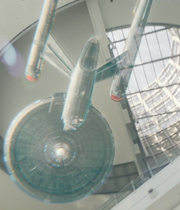
|

| |
The implied intent accrued credence when the redesign made three later reappearances outside the Discovery framework. Two retcon-Constitution-class vessels reappeared as a graphic on a computer display in the Star Trek: Short Treks episode "Ask Not", a fictionalized version of James T. Kirk's Original Series ship made a more prominent appearance in the later Short Treks episode "Ephraim and Dot", and a subsequent holographic representation was featured in the lobby of Starfleet Headquarters in the season one Star Trek: Picard episode "Maps and Legends". While the hologram could easily be construed as a homage to Christopher Pike's ship of the specific Discovery-era, the appearance of the design as Kirk's Original Series-era ship, though part of a movie retelling the ship's exploits, is much harder to explain away, and for all intent and purposes constituted the first actual retconning of the ship in canon. This was all the more remarkable as the interiors shown in that episode adhered more closely to the ones as seen in The Original Series.
Additionally, the officially licensed reference book Star Trek: Discovery Designing Starships stated on page 191 that "(..)the Discovery version was the same ship that Kirk commanded at an earlier stage of its life, before several refits", further indicative of the producer's implied intent, even though the remark in itself did not rule out a return to the Original Series configuration, something co-designers Eaves and Schneider actually – and wishfully – proceeded from themselves. [21]
It was the suspected canon replacement of Jefferies' iconic design that critical fans, even those that have favorably received the Eaves/Schneider retcon design, [22] reject out-of-hand. [23] The premiere of Star Trek: Strange New Worlds on 5 May 2022 seemed to definitively settle the matter once and for all; the Kurzman-era Constitution-class retcon version was indeed intended as the canon replacement of Jefferies' classic design. Still, it were the season three showrunners of Picard, staunch Original Series fans to a man, who invalidated whatever intentions, if any, there might have been for Jefferies' classic Original Series design, by visually inserting it into the episodes PIC: "The Bounty", "Võx", "The Last Generation" in the guise of USS New Jersey.
Appendices[]
Related topics[]
Further reading[]
- "U.S.S. Enterprise", Star Trek: The Art of John Eaves, November 2018, pp. 202-205
- Star Trek: The Official Starships Collection, issue XL11, December 2018
- Star Trek: Discovery The Official Starships Collection, issue 12, March 2019
- "Designing The Enterprise", Star Trek: Discovery Designing Starships, September 2019, pp. 190-203




